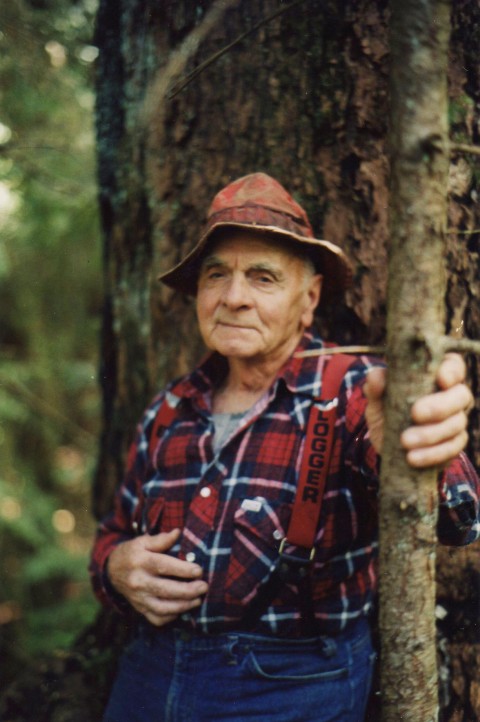
On the front cover of Canada’s first comic book, Better Comics No. 1 (March, 1941), Vancouver’s Maple Leaf Publications chooses a stylized maple leaf containing the words “Canada’s Own” to be its logo. These words broadcast the mission mandate through which Vernon Miller created his comics out on the West Coast. Given this, what could be more Canadian than Bus Griffith’s “Now You’re Loggin’” comic book feature on felling trees in the BC wild which first appeared in one of those Maple Leaf comic books.
Gilbert Joseph (“Bus”) Griffiths was born on the Prairies, in Moose Jaw, Sask. on July 9, 1913. His parents Joseph and Rachel were both born in England with Rachel coming over in 1907 and Joseph in 1909. They must have met and married shortly after Joseph arrived because their first son, Ernest was born around 1911, then Bus, and finally his sister Edith a couple of years later. The family quickly moved to Penticton BC where Bus lived his youngest years and then to Burnaby in 1922. Griffiths says that it was his father who first encouraged him to draw:
I was a hard kid to get to bed and my father used to tell me if I got to bed and went to sleep that the little elves would come and draw a picture in my scribbler. I’d wake up in the morning and find the scribbler tucked under my pillow and there’d always be a drawing in there somewhere. I think that’s what got me drawing. (Bus Griffiths, Logger and Artist, 1913-2006, Obituary by Grant Shilling, The Globe & Mail, Dec. 8, 2006)
A local butcher kept calling him “Buster” and this stuck in the form of “Bus.” He initially worked as a cataloguer for Massey-Harris who made farm implements but soon found his vocation as a faller (the person who brings trees down with precision) in logging camps all over British Colombia. Bus, with no success, to market some of his drawings to local newspapers, then in the fall of 1941, came a break:
…when there was a shutdown in the mill and American comics weren’t coming up because of the austerity program, and I saw this ad in a Vancouver newspaper from some place called Maple Leaf Publishing looking for people to do comics. So I roughed in two or three pages and took ‘em in. The fellow there [Vernon Miller?] said, “We’ll take it, make it into an eight-page episode.” They seemed to like it… Then I started a Western serial. They had about four different comics and “Logging” was in Rocket. But I had to stop doing ‘em when I got sent up to Port Hardy and got froze in the woods there. (Shawn Conner, “I’d Rather be Fishing: A Conversation with Bus Griffiths” The Comics Journal #187, May, 1996.
About twenty years previously to the above quotation, Bus gave a similar account to poet and friend Peter Trower in Peter’s column “Pages from a Life Log” (Coast News, March 15, 1977, p. 5) stating that he was working on Burke Mountain near Port Coquitlam:
I saw in the paper that the Maple Leaf comics were starting up and wanted cartoonists. I took in some of my old western strips. The editor [again, Vernon Miller?] was interested and asked me if I had any other ideas. I told him I’d often thought to try a strip about the woods. That’s how the original “Now You’re Logging” series got started.
Actually, Bus’ “Now You’re Loggin’” strip began in the pre-Rocket title called Name-It Comics (Nov.-Dec., 1941). Maple Leaf had already put out Better Comics and Lucky Comics earlier in the year and at the end of 1941 put out two more titles, Bing Bang Comics and Name-It for which it chose the gimmick that the readers would come up with its name. Name-It Comics and it had this title for only one issue because with the second issue it became Rocket Comics, the name chosen as the contest winner with the winning entrant being Sheldon Kasner of Montreal. His other strip was the western “Son of the Range” which also in Rocket Comics.
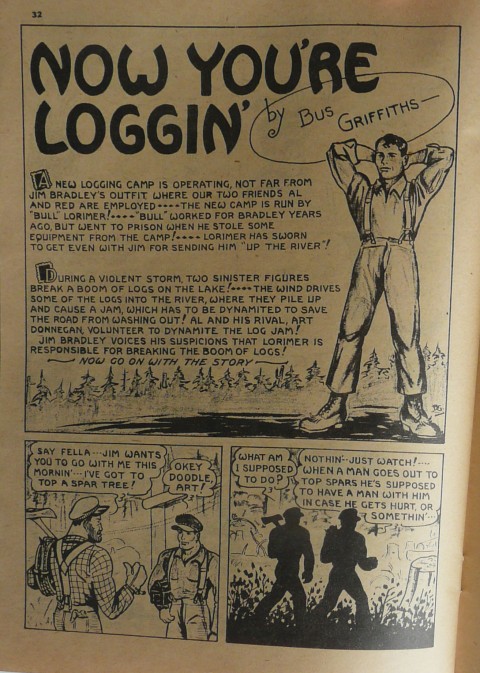
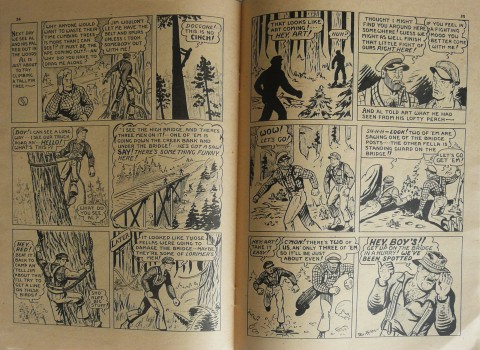
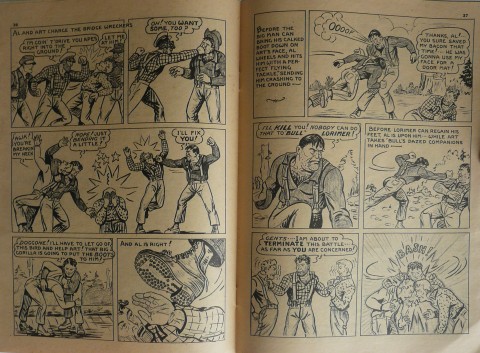
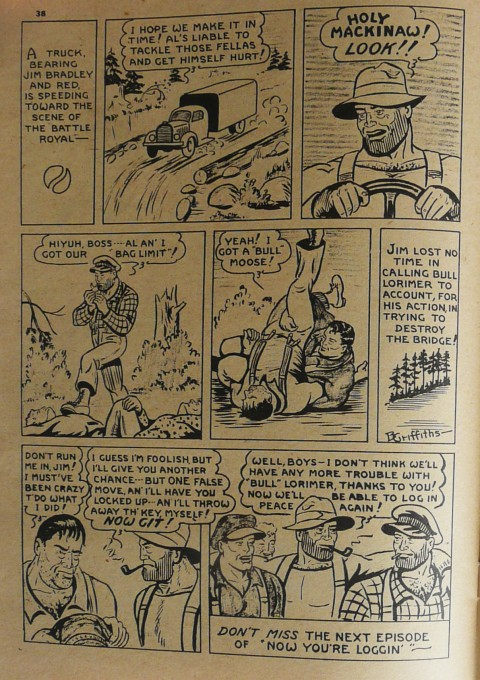
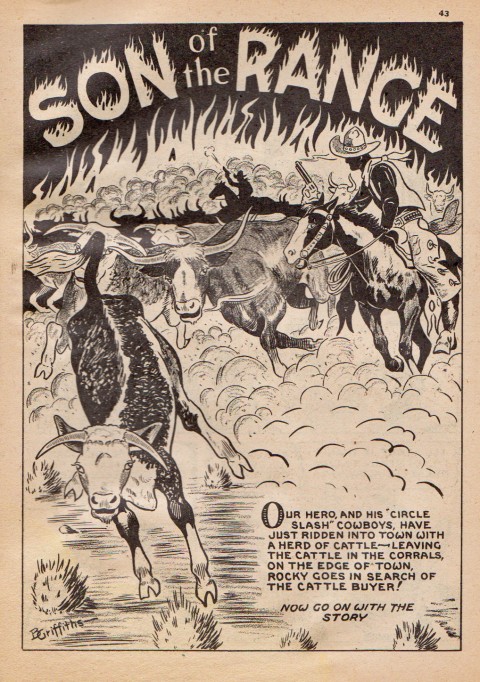
Bus had already gotten married to wife Margaret in 1940 and, in fact, missed being sent overseas again because he was frozen in on one of his logging jobs (see Conner, p. 113). He ended up working for Maple Leaf for about a year but by 1943 the demands of his work as a logger forced him to drop his comic work. By 1944 Bus and his wife were settled in Fanny Bay, a little inlet community, just about in the middle of the east coast of Vancouver Island. From this base he became an itinerant logger right up to the early sixties at which point he took up trawler fishing as a main livelihood but continued to do some logging once fishing season was over.
In the early seventies, Griffiths had some of his paintings purchased by the Courtenay Historical Society and the resulting favourable reviews encouraged him to take up the “Now You’re Logging” project again and installments were published in the trade magazine B. C. Lumberman and then later in the cultural anthology periodical Raincoast Chronicles put out by Harbour Publishing. It took him five years of careful attention to detail and drawing and by 1978 Now You’re Logging was published full-blown by Harbour Publishing and has since become a classic in the field with the first edition hardcover selling upwards of $1000.
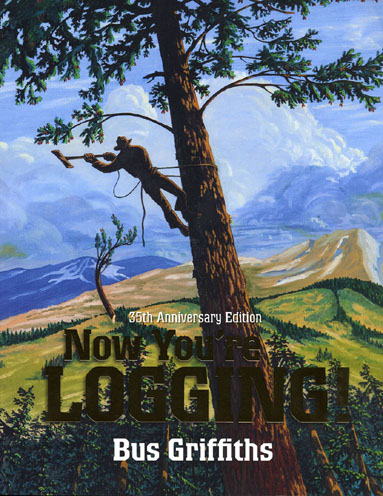
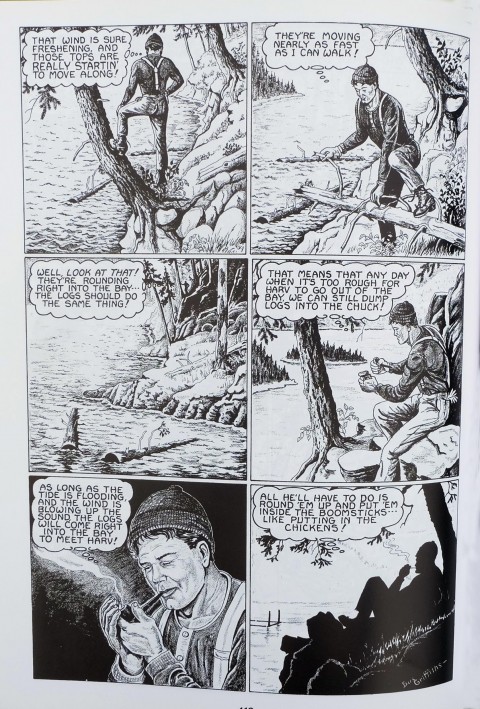
This is one of Canada’s first graphic novels. It’s steeped in dense, rolled-up plaid sleeves and suspenders argot and dripping with an authenticity that quietly asserts the integrity and sense of custodianship (of a bare-hand and genuine way of earning a living) in the soul of its author. (See Brad McKay’s splendid summary of the worth of this work, “Muck Sticks, Whistle Punks, and Donkey Punchers”).
Around the same time that Now You’re Logging came out as a hard cover, Peter Trower got Bus to do some illustrations for his collection of poetry called Bush Poems (Harbour Publishing, 1978). Trower also included, in the middle of the book, a series of six of Bus’s drawings of an old-time high rigger in the process of topping a spar tree in appreciation of the quality of Bus’ work.
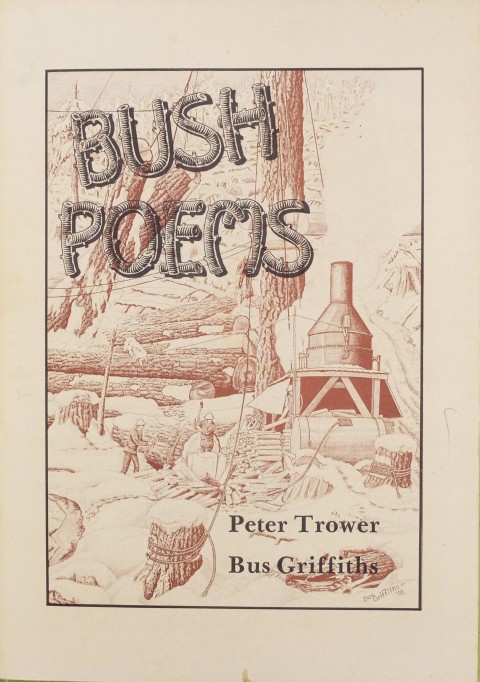
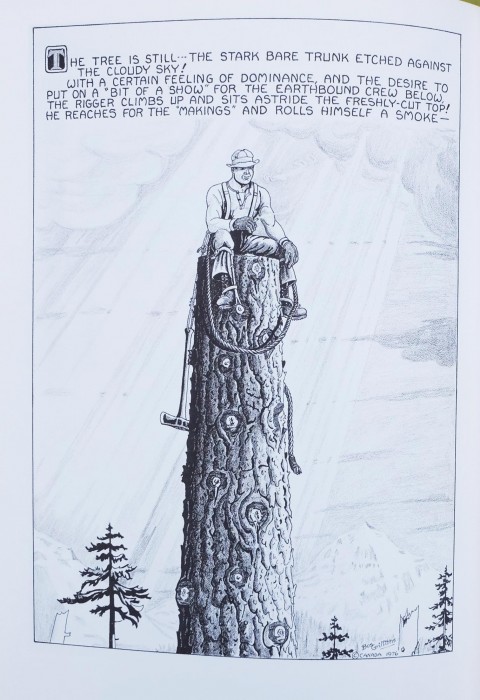
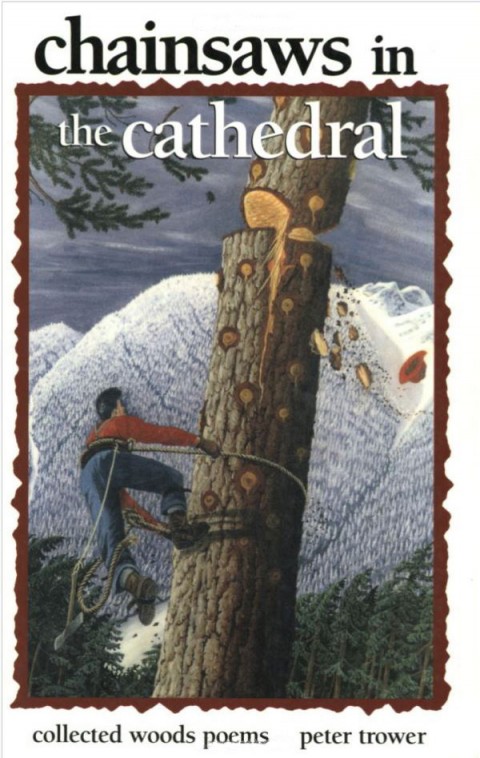
About a dozen years later, Bus provided the illustrations for a children’s story called Patrick and the Backhoe (Nightwood Editions, Madiera Park, B.C., 1991) written by Howard White, who started Raincoast Chronicles.

Later in life, Bus Griffiths transitioned to oil painting and a number of these hang in the Courtenay District Museum and the Fanny Bay Community Hall. Though Bus at times thought about getting some art training he never did. He was completely self-taught and his idiosyncratic representations add more to the genuineness and charm of his work.
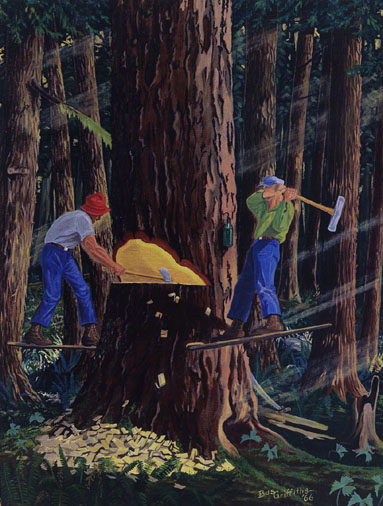
Bus Griffiths died from prostate cancer on September 25, 2006 in Comox, B. C. leaving behind his wife Margaret and sons Gilbert and Stephen. Few people find out what they are made for in life and no one in panel illustration fit more snuggly into his dharma than Bus Griffiths. He’s still logging.

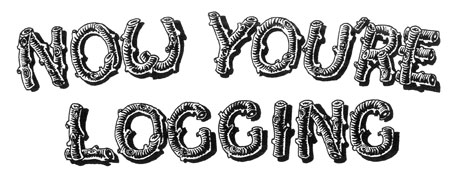



Have to make a correction. The “Son of the Range” splash by Bus is not from Rocket Vol. 1 No. 7 but from Rocket Comics Vol. 2 No. 2.
A great informative piece Ivan. Thanks for the shout-out to my TCJ piece; this one fills in a lot of the historical gaps that I was unable to address.
Your piece raises a few questions for me:
1) Griffiths says “I saw in the paper that the Maple Leaf comics were starting up and wanted cartoonists. I took in some of my old western strips.” Do you think he means to say here that these strips had been previously drawn by him? If so, when did he draw them and for whom? Very interesting in that there wouldn’t have been much of a comics market for these prior to 1941, so maybe he drew this and shopped it around to newspaper editors as a comic strip feature? He does say “my old western strips.” Pure speculation — but fun nonetheless.
2) The logging story you ran here is not included in the “NYL!” GN, which makes me think that he redrew/rewrote it at some point: I’m guessing the 1970s. Which means the original stories are real finds (as much as any CW story about logging in BC in the 1930s can be a “find” i suppose). Still, i think it’s worth noting that you’ve unearthed an early, unreprinted Bus Griffith’s logging story. Do you have any more?
3) That splash page for the cowboy story is really good. Possibly better than his logging stuff, from a pure artistic sense anyway. I want to see more! It also begs the question about his other work: at some point he talked about a longer story that he had drawn (a GN) that disappeared in the 1980s. I think he said somebody had stolen it. Alas, we’ll never see it now.
Thanks again for doing this piece! A real eye-opener, plus it’s comforting to know that other people are also interested in this arcane, eclectic corner of comics history.
Thanks for your comments and questions, Brad, and for your earlier work on Bus. I can offer the following information on your points.
1. Shawn Conner’s 1996 piece in The Comics Journal mentions that, before Bus published anywhere in the 1920s as a teenager, he took early work (I imagine it was a portfolio of sorts that would have some of his efforts at Western strips) to two Vancouver newspapers, The Sun and The Province without success. About twenty years earlier, Peter Trower in his ongoing column in The Coast News says just about the same thing (I’ll send you a copy). To the best of my knowledge, Bus’ first published work is the Now You’re Loggin’ strip in Rocket Comics running from 1941 to early 1943.. It would be great to get all these together along with the few Son of the Range Western strips that Bus did reprinted.
2. Yes I think all the Griffiths work in Rocket Comics has only ever been published there. To me, these dozen or so NYL strips represent a formative stage of his eventual grand idea. These second world war strips represent the experiences of a younger man in his late twenties. Peter Trower in his March 15, 1977 column in The Coast News entitled “Pages from a Life Log” states the following: “Bus worked the Burke Mountain claim by day and drew the strip [NYL in Rocket Comics] at night and on the weekends.He later launched a Western strip called “Son of the Range.” He kept up the gruelling schedule for a couple of years but the burden was to prove too much.In 1943 he was obliged to discontinue both strips.” As I’ve said there are probably about a dozen NYL Rocket Comics strips and I’m still finding out more about “Son of the Range.” Our ongoing project of indexing all the Canadian Whites will get to recording more of these eventually. In the early seventies, now sixty years old he seems to have been inspired to take up his grand idea for NYL anew, encouraged by his wife and the successful publishing of new installments of the NYL in The B.C. Lumberman and Raincoast Chronicles, and over 5 years produced his magnum opus, the NYL hardcover put out by Harbour Publishing in 1978.
3. I have yet to see a reference to another Graphic Novel that Bus did, Brad so I can’t offer anything here.
Thanks again for your great questions.
Bus was unique in that he was involved in the whole cycle of the tree from its growth, harvesting, and then putting his adventures onto its most refined product,paper, in one of Canada’s culturally iconic occupations.
What a wonderful life he must have had finding his calling early and doing what he loved for so many decades.
We were lucky enough to be able to share his love by his artistic talent and generous nature to want share it with the world.
Now I have to go find some of these books you have brought to our attention.
Great article Ivan.
Thanks, Jim. I’d like to find out exactly what issue of Rocket Comics in 1943 the Now You’re Logging and/or the Son of the Range strips last appeared. The last issue I have reference to now with a Bus Griffiths strip in it is Rocket Vol. 2 No. 2 from May/June 1943. The first volume had 8 issues so this would have been the tenth issue in the run. I’d certainly like to see that very first Loggin strip in Name-It Comics 1 and love to share it with everybody.
Who ever bought the Rocket Comics V2_3 in the Feb CLINK Auction or the owner of a V2_4 knows which book had the last “Now You’re Loggin” story.
Can’t help you there so hopefully someone reading this will chime in.
Check your email for some scans of the first Maple Leaf “Now you’re loggin” story.
Thanks for those scans, Jim. I’ll try to put them up in next week’s post.